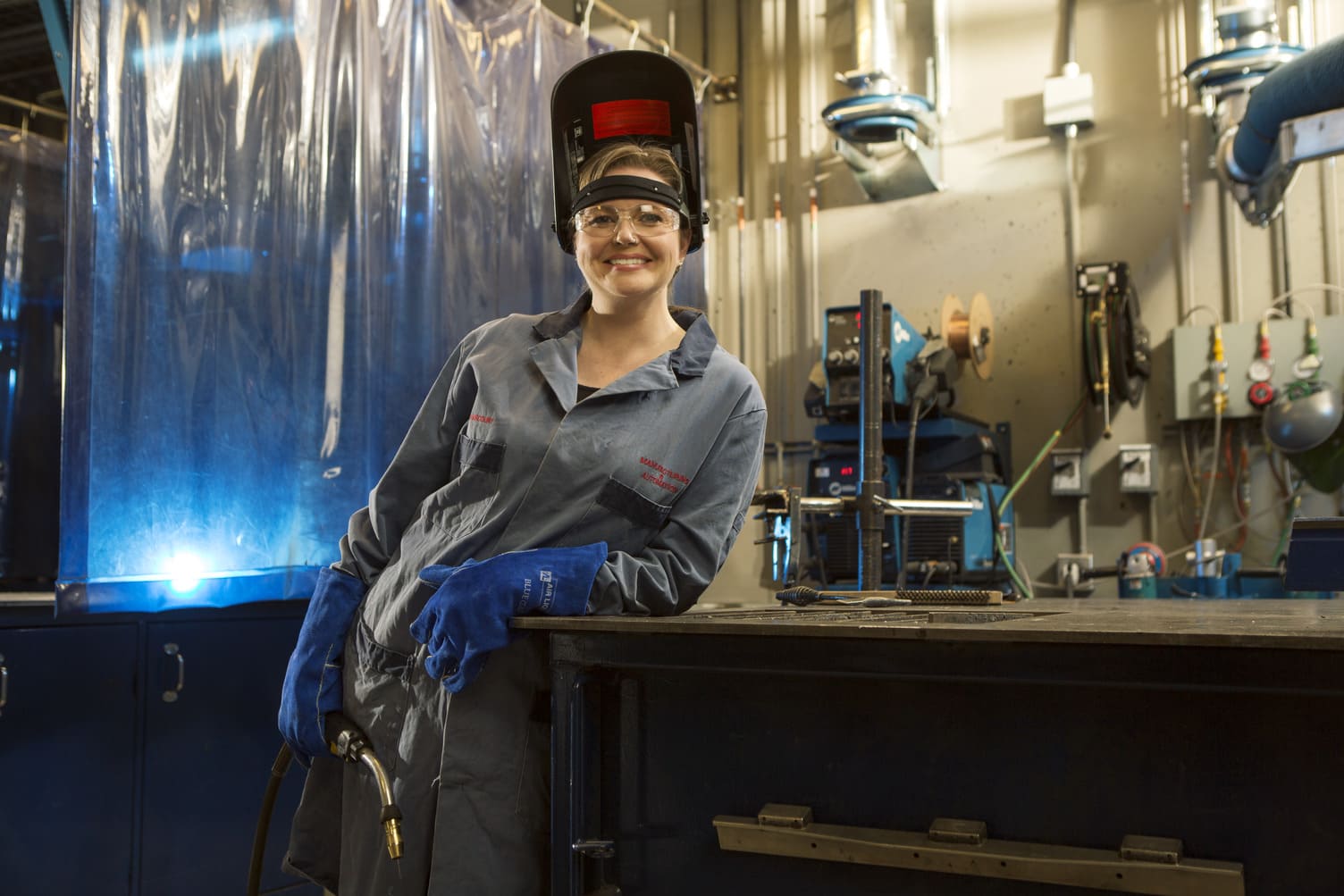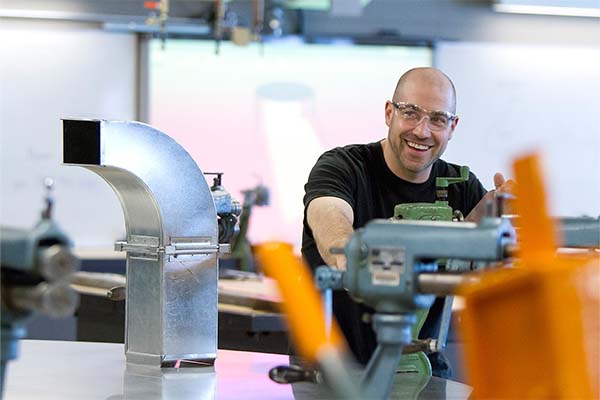On this page:
Overview
Learn how to design, fabricate, assemble, install and repair sheet metal products required in various industries and settings.
You may work with various types of metal, including black and galvanized steel, copper, brass, nickel, stainless steel and aluminum, to craft a variety of products, including:
- heating, ventilating and air conditioning systems
- solar heating and cooling systems and all integral equipment
- metal showcases, display neon and metal sign equipment
- metal cabinets, custom-built tables, counters and fixtures for hospitals, kitchen equipment and items for the food service and beverage industry
- electrical panels and related equipment
- dairy, brewery and laboratory equipment
- metal shelving, lockers, window frames, metal doors and frames and toilet partitions
- flashing, coping, troughing and roof drainage systems
- custom or small-run fabrication of a variety of sheet metal items.
This is a compulsory trade, which means to work as a Sheet Metal Worker you must be a registered apprentice or journeyperson.
This is a dual certification trade. Along with your Sheet Metal journeyperson ticket, you will also obtain a Gasfitter - Class B journeyperson ticket at the end of your training, allowing you to install and service all gas appliances up to 400,000 BTUs and install up to five-ton air conditioners.
Sheet metal workers are skilled tradespeople who like collaborating with others and working independently.
This line of work is most fulfilling for those who enjoy working with their hands in various environments and developing specialized skills.
To succeed in this trade, you should:
- enjoy problem-solving
- be creative
- have mechanical aptitude
- have good eye-hand coordination, spatial and form perception
- have a reasonable level of fitness to carry heavy tools and manual dexterity
- be able to visualize a finished product from a drawing
- have a good understanding of practical mathematics and geometry
- be able to stand for long periods
- be patient, dependable and accurate
- be comfortable working in a construction or shop environment
- have good communication skills
- be comfortable working alone or as part of a team
- be committed to maintaining safe working conditions.
Upon successfully completing the required working hours and technical training periods, you will be awarded an advanced diploma in addition to journeyperson status by Alberta’s Apprenticeship and Industry Training.
This is a Red Seal Endorsed trade – a recognizable standard that allows tradespeople to work across Canada.
Careers and opportunities
Our graduates may work in the following occupations. Some careers require additional experience and education.
Associated National Occupational Classification (NOC) codes: 72102, 72010, 72020, 72402, 94105, 70010, 22303, 72104.
Apprenticeship training
The term of apprenticeship for a sheet metal worker is four years (four 12-month periods), including a minimum of 1500 hours of on-the-job training and ten weeks of classroom instruction each year.
Year 1 | Period 1
You will start by learning about safety, tools and equipment. You’ll also cover duct construction using simple and conical line pattern development, welding and cutting processes, residential HVAC drawings and residential HVAC installation.
Training length: 10 weeks
Year 2 | Period 2
You will learn fabrication using parallel line pattern development, light commercial HVAC and HVAC heating appliance installation.
Training length: 10 weeks
Year 3 | Period 3
You will learn gas tungsten arc welding (GTAW) and plasma cutting for specialty metals, duct construction using triangulation pattern development and commercial HVAC.
Training length: 10 weeks
Year 4 | Period 4
You will then learn advanced fabrication, gas metal arc welding (GMAW) for specialty metals, commercial and industrial HVAC, refrigeration and diagnostics.
Training length: 10 weeks
Apprenticeship education performance
You must pass each section of the course and the AIT exam to succeed in apprenticeship education.
The passing grade for each period is no less than 50% in each course, with no less than a 65% average overall. A passing mark on each provincial exam and the interprovincial qualification (Red Seal Exam) is 70%.
View Alberta's Apprenticeship and Industry Training procedures
Training pathways
You can earn your journeyperson designation in the following way.
The traditional training pathway begins with finding a job with an employer willing to indenture you as an apprentice. Once you are an apprentice, you will alternate between on-the-job training and educational periods.
You must apply for an apprenticeship through Alberta Apprenticeship and Industry Training before attending your first education period at SAIT.
Admission requirements
To enter an apprenticeship, you must have the educational qualifications required or recommended education for the trade to which you apply.
Entrance requirements are monitored and set by Alberta Apprenticeship and Industry Training.
Minimum requirements
Successful completion of the following courses:
- English 20-2
- Math 20-3
- Science 10
OR
A pass mark in all five Canadian General Educational Development (GED) tests
OR
Alberta Apprenticeship and Industry Training Entrance exam.
Recommended requirements
Apprentices with an Alberta High School Diploma that includes the following courses:
- English 30-2
- Math 30-3
- Physics 30 OR Chemistry 30 OR Science 30
- Related career and technology studies (CTS) courses

MyTradeSecrets
Once you have begun working as an apprentice, you can attend SAIT to complete your technical training.
You'll register for technical training at SAIT on MyTradeSecrets or you can register by phone.
Transfer agreements
At SAIT, we have created transfer agreements with partner institutions to allow you to earn course credits toward your SAIT program based on your previously completed credentials.
Transfer Alberta search tool
Use the Transfer Alberta search tool to see all transfer agreements between Alberta post-secondary institutions (including those with the University of Calgary, Mount Royal University and Bow Valley College.)
Search transfer agreements in Alberta
There are no formal transfer agreements currently in place for this program.
Transfer options for graduates
When you have completed this program, you may continue your education at a partner post-secondary institution. These transfer agreements include partnerships within and/or outside of Canada.
Credits this program transfers to
- Available credits:
- 45
As a certified tradesperson with at least one year of full-time work experience in the field and the necessary English and introductory business prerequisites, you can apply to the University of the Fraser Valley’s Bachelor of Business Administration for Trades Management.
This five (5) semester program complements your prior learning with the fundamentals of business management theories and practices. This will help you successfully function as a manager or owner of a trade-related business in today's rapidly changing global environment.
- Available credits:
- 57
- Available credits:
- 60
Available intakes
Costs
2025/26 tuition and fees
The following costs are effective as of July 1, 2025.
This is a bring-your-own-device program with a standard computer hardware and software requirement. See the specific requirements on our computers and laptops page.
Books or modules, along with other items for classes, are approximately $600 per period.
We recommend you don't purchase books or modules ahead of time as they might be outdated by the time you attend classes, and they cannot be returned to the Bookstore.
This program requires personal protective equipment (PPE), which may be an additional cost.

Funding options for apprentices
Apprentices get to learn while they earn, but there are still costs to consider. Many resources are available at SAIT and federally to help support apprentices.
Information sessions
Prepare for a strong start in your chosen program or get the details you need to decide your future path.
Our expert staff and faculty are ready to answer your questions and provide information about the following:
- What sets SAIT apart
- An introduction to the program and area of study
- Admission requirements
- Future career paths
- Information on the earning potential and graduate employment rates.
Contact
Have more questions?
Apprenticeship training and registration
Apprenticeship and Industry Training Client Services

Oki, Âba wathtech, Danit'ada, Tawnshi, Hello.
SAIT is located on the traditional territories of the Niitsitapi (Blackfoot) and the people of Treaty 7 which includes the Siksika, the Piikani, the Kainai, the Tsuut’ina and the Îyârhe Nakoda of Bearspaw, Chiniki and Goodstoney.
We are situated in an area the Blackfoot tribes traditionally called Moh’kinsstis, where the Bow River meets the Elbow River. We now call it the city of Calgary, which is also home to the Métis Nation of Alberta.
